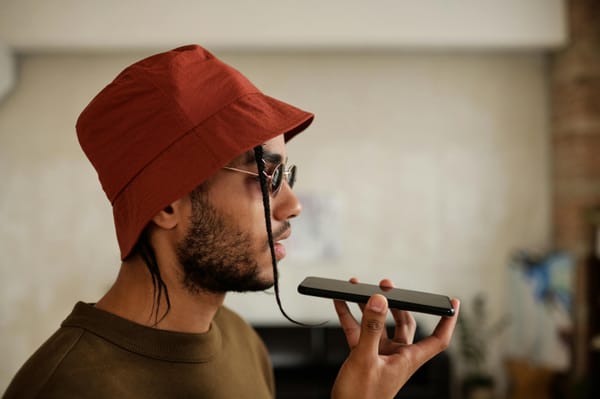What is SMS Broadcast? 5 Advantages for Small Businesses

In recent years, there’s been a noticeable shift from traditional email marketing toward SMS marketing, and for good reason. While email inboxes have become oversaturated with promotions and newsletters, text messages offer a direct, immediate connection to customers.
SMS broadcasts, in particular, are emerging as one of the most powerful tools in the digital marketer’s and business owner's toolkit, boasting open rates as high as 98% and engagement rates that email simply can’t match.
Senior digital marketing expert Nadine Hawel puts it best:
“I think with email, brands have gotten so used to sending emails to our inbox every day that our inbox gets so flooded. Had I gotten an SMS in that moment, I would have acted right away. That’s why it’s so powerful, we are naturally on our phones!”
As consumer behavior continues to evolve, businesses that embrace SMS now are likely to gain a serious edge.
What is SMS Broadcast?
SMS Broadcast lets businesses send a single text message to many customers at once, just like an email blast, but faster and more direct. People also call it bulk SMS or mass texting. You can use a template or write your own message, then deliver it instantly to your audience’s phones. It's a simple, powerful way for small businesses to stay visible and drive engagement in real time.
SMS broadcast vs group messages: What is the difference?
Unlike group messages, which show replies to everyone and are limited to about 100 recipients, SMS broadcasts send the same message individually to each person. Replies stay private, avoiding the clutter and confusion of group chats.
SMS vs MMS: What is the difference?
SMS stands for Short Message Service. It’s used to send plain text messages up to 160 characters, no images, videos, or formatting.
MMS stands for Multimedia Messaging Service. It lets you send pictures, videos, audio, and longer text messages. MMS is great for more visual or engaging content, while SMS is best for quick, simple updates.
Cost Structure: MMS messages typically cost two to three times more than SMS messages, which is important to consider if you have a small business and would rather save costs.
Format Flexibility: SMS is simple, reliable, and works on every mobile phone. MMS allows for more creative content but comes with file size limits (usually around 5MB).
Your communication goals determine whether to use SMS or MMS broadcasts. SMS broadcasts work best for quick, text-based notifications or alerts. MMS broadcasts shine when you need visual elements or longer content.

What is the Purpose of SMS broadcast?
Not every brand needs SMS marketing, but for businesses that value fast, direct communication with their audience, SMS broadcast can be a powerful tool. It generally serves two main purposes:
- Marketing and Promotions – SMS broadcasts are ideal for sending time-sensitive offers, launching new products, promoting seasonal sales, or rewarding loyalty program members. If you sell goods or services online, this can be a fast, high-impact way to drive traffic and conversions.
- Customer Service and Engagement – SMS broadcasts can also help strengthen customer relationships. For example, if multiple customers have contacted you about the same issue, you can group them and send a personalized bulk message addressing their concern. Or you might use SMS to send thank-you notes after purchases or follow-ups to make sure an issue was resolved.
Whether you're promoting a flash sale or making sure your customers feel heard, SMS broadcasts can offer both marketing impact and a more human touch.
How can SMS Broadcast help my business?
SMS broadcast gives small businesses several powerful advantages:
Quick Results: People usually see broadcast messages within minutes. This works great for flash sales, urgent updates, or time-sensitive promotions.
Wide Reach: Anyone with a mobile phone can get text messages, whatever type of phone they have. You can reach more people than with apps or emails.
Affordable Options: SMS broadcasting costs much less than print, radio, or TV ads. A few business phone solutions offer SMS broadcast options for affordable pricing, which helps growing businesses.
Personal Touch: SMS broadcasts can include recipient names and custom fields, even though they're mass messages. This creates better engagement.
Two-Way Talk: Modern SMS broadcast services let recipients reply, which opens direct customer conversations. This two-way feature builds stronger relationships and customer loyalty.
SMS broadcasting is a fast, cost-effective, and highly personal way to reach your audience. Whether you're promoting a sale, sending reminders, or starting conversations, it helps small businesses connect with customers in a meaningful and efficient way. With the right tools and strategy, SMS can become a powerful part of your communication toolkit.

How to Get Started with SMS Broadcast
SMS broadcast systems need proper planning and the right tools to work well. You need practical knowledge about implementation beyond just knowing what SMS broadcasting means. Let's look at how to get your system running smoothly.
Choosing the right SMS broadcast software
To get started with SMS broadcasting, you'll need more than just a regular mobile phone. Businesses typically use either specialized SMS broadcast software or a virtual business phone system that includes strong messaging features.
- For larger businesses that need to send high volumes of MMS or highly personalized messages with advanced automation and integrations, a dedicated SMS broadcast platform like Postscript is a better fit.
- For small to mid-sized businesses looking to use SMS both for marketing and for improving customer engagement and service, a virtual business phone system like Ringo offers a simple but powerful SMS broadcast feature, perfect for sending bulk messages while still keeping things personal and manageable.
SMS broadcast features to look out for
For larger companies:
If you're a large business looking to run structured, data-driven SMS marketing campaigns, it's important to choose an SMS broadcast solution with robust features.
- Automation capabilities - Look for platforms that let you create custom workflows. These should trigger messages naturally when customers sign up or make purchases
- Segmentation tools - The best software lets you group contacts based on demographics, what they buy, and how they interact
- Personalization options - Pick solutions that blend in custom content like customer names or their previous purchases
- Analytics and reporting - Detailed analytics showing delivery rates, opens, and conversions help you see how well your campaigns work
- Compliance features - The platform should follow TCPA and GDPR rules and include built-in consent management
For smaller businesses:
We believe a simple yet effective solution is the best fit for small businesses. Why? Because most don’t have a dedicated marketing team to manage complex campaign flows. Instead, they need a straightforward set of features that make it easy to reach out to customers, whether for basic marketing or to enhance customer service.
- Templates: Tools like Ringo let you create and save message templates, making it easy to reuse messages you send frequently. Need inspiration? Click here for SMS template ideas, or create your own using AI here.
- Tab Segmentation: Choose tools that let you organize your customers into tabs or lists for easier management. For instance, with Ringo, you can filter messages by categories like “Unread” or “Needs Reply,” then bulk-select those contacts to send a targeted SMS broadcast.
- Compliance features - The platform should follow TCPA and GDPR rules and include built-in consent management.
How can I collect phone numbers?
Having SMS broadcast is powerful, but how do you build the list to send messages to? We've put together a full guide to help you grow your SMS contacts, but here are a few quick strategies to get started:
- Website pop-ups and forms – Capture numbers during browsing or before checkout.
- Checkout opt-in – Let customers sign up during the purchase process.
- Text-to-join keywords – Use simple keywords people can text to subscribe.
- QR codes – Add scannable codes to receipts, signs, or packaging.
- Convert email subscribers – Invite your email list to join your SMS list.
- In-store and event sign-up – Use signage or staff to promote opt-ins in person.
- Partnerships and giveaways – Run co-branded promotions or contests requiring phone number entry.
How to Send SMS Broadcast Messages Step-by-Step with Ringo
Every business phone or marketing platform handles SMS broadcasts a bit differently, but at Ringo, we’ve made the process as simple and efficient as possible, especially for small businesses.
Here’s how it works:
- Click the “New Message” icon
Start by opening the message composer. - Select your contacts
Manually choose the contacts you want to message. You can add them one by one, or quickly select an entire tab, like all “Unread” or “Needs Reply” messages. - Write or choose your message
Type out your message or use a saved template for faster communication. - Click “Send”
That’s it! Your broadcast message goes out in seconds.
It’s fast, easy, and designed to fit the needs of growing small businesses.
Now, what are some of the advantages of SMS broadcast? Let’s list them down one by one.

Advantage 1: Reaching Cold Leads Without Being Intrusive
Cold leads create a tough challenge for small businesses: how to grab attention without being pushy or intrusive. SMS broadcast stands out as the perfect solution for your original outreach.
Why SMS is less invasive than calls or emails:
Immediate but not interrupting: Unlike calls that need instant attention, SMS lets recipients read and respond when it suits them. This creates a more relaxed interaction.
Concise communication: Text messages are short by nature. Recipients quickly understand your offer without reading through walls of text.
Greater recipient control: SMS gives more power to recipients. They see the message without feeling rushed to respond. They also have simple opt-out choices, so they retain control over how you communicate.
Extraordinary visibility: The best part about reaching cold leads is the amazing 98% open rate for text messages. Your message will almost always be seen, unlike emails that people open much less often.
Best practices for first-touch SMS campaigns
These protocols will help you keep your first SMS contact with cold leads respectful:
Start with a simple greeting: Every cold SMS conversation should begin with a simple hello. One expert suggests, "Start every cold SMS conversation with a simple greeting. A 'hello,' 'hi,' or 'hey,' followed by the prospect's first name". This feels more human and helps dodge spam filters.
Get proper consent: You need proper permission before contacting cold leads. Most places have rules about SMS marketing. The Federal Communications Commission requires businesses to get customer consent before sending texts.
Perfect your timing: Don't send messages during rush hours (6:30-8:30 am and 4-7 pm) when recipients might be driving. Mid-morning and early evening usually work better for engagement.
Keep it conversational: A friendly, casual tone works better than formal business language. This builds a personal connection and makes people more likely to respond.
Avoid sales-heavy first messages: Start with conversation instead of selling right away. One source explains, "The right way to use SMS in your sales strategy is to use it as a place to start or rekindle a conversation. That ensures your first text message isn't a sales pitch, it's simply trying to involve your potential customers".
Personalize appropriately: Make messages relevant even for cold leads. Data shows that 72% of consumers will only respond to individual-specific messaging. You could mention their industry, location, or a specific problem your business solves.
Use SMS templates efficiently: Create templates for different situations to save time while keeping things personal.
Include clear opt-out instructions: Always show recipients how to opt out of future messages. This builds trust in your brand and respects their choices.
SMS broadcast strikes the perfect balance between visibility and respect when done right. It works great for warming up cold leads without causing the annoyance that often comes with cold calls or unexpected emails. High open rates and the non-intrusive nature of texting create ideal conditions to reconnect with prospects who might otherwise stay out of reach.
Advantage 2: Re-Activating Dormant Customers with Targeted Texts
Small businesses often struggle with dormant customers who bought something but haven't come back in months. Research shows that getting new customers can cost substantially more than keeping existing ones. SMS broadcast helps bring these customers back and boost your profits.
Using past purchase data to trigger messages
If you’re a small business owner who spends most of the day out in the field, showing homes, handling service calls, or meeting clients, it’s easy for old customers to slip through the cracks. But here’s the good news: A quick text can go a long way in bringing them back.
Use past customer behavior and simple messaging to reconnect while you're on the go.
Here are smart, low-effort ways to re-engage customers using text:
1. Follow Up After On-Site Visits
If someone got a quote but didn’t book, or toured a property but didn’t follow up, send a short message a few days later:
- “Still thinking about that kitchen remodel? We’ve got a summer special running.”
- “Hope you enjoyed the open house! Want to see similar homes nearby?”
2. Rebook Past Clients
Haven’t seen a regular in a while? Use SMS to check in and remind them:
- “It’s been a few months since your last appointment, ready for a refresh?”
- “We’re filling up fast for August. Want us to save you a spot?”
3. Share Limited-Time Offers
People love a good reason to return. Use SMS to create urgency with promos or seasonal updates:
- “Free home valuation this week only, text back to claim.”
- “10% off HVAC tune-ups this month. Text YES to book.”
4. Solve Silent Drop-Offs
If a customer ghosted after a service inquiry, keep it casual:
- “Just checking in, still interested in lawn care before the season ends?”
- “We’ve updated our packages based on your feedback. Want a quick look?”
SMS works because it's immediate, personal, and easy to respond to, even for busy folks like your customers. You don't need complicated funnels. Just thoughtful timing and a few lines of text.
Advantage 3: Boosting Loyalty Through Exclusive SMS Offers
Loyal customers want to feel valued, not just sold to. A quick, personalized text can go a long way in showing you care. Whether it’s early access to your calendar, a thank-you after a third visit, or a VIP-only offer, SMS makes it easy to treat returning customers like insiders.
When people feel seen, they come back, and bring others with them.
Great VIP broadcast messages include:
- Status recognition: "As one of our valued VIP customers..."
- Exclusive access: "Early access just for you, shop 24 hours before everyone else"
- Special pricing: "VIP members receive an additional 10% off already discounted items"
- Limited availability offers: "Only 50 VIP bundles available, claim yours now"
Small businesses can encourage long-term loyalty while driving quick sales through urgency-based promotions by utilizing SMS broadcasts for exclusive offers and VIP communication.
Advantage 4: Boosting Customer Service
When you need quick replies, SMS delivers. Here’s how small businesses use it every day:
Appointment Reminders
A simple text can save hours of wasted time. Use reminders to:
- Cut down on no-shows and last-minute cancellations
- Let clients confirm or reschedule with a quick reply
- Keep your calendar organized without back-and-forth calls
Texting helps you stay on schedule while making clients feel cared for—quick, easy, and professional.
Advantage 5: Affordable and Scalable for Growing Teams
For small teams, every dollar counts. That’s why SMS marketing through your business phone system is such a smart move. Instead of juggling multiple tools or paying for bulky platforms, you can send professional text broadcasts as part of a system that starts at just $15/month.
It’s a simple, scalable way to stay in touch with customers, whether you're sending promos, reminders, or follow-ups.
Compared to traditional marketing channels, SMS is not only more affordable, it delivers bigger results:
- SMS: Up to $71 return for every $1 spent
- Email: $36 per $1
- TV, radio, and print: Often below $10 per $1
That makes texting one of the highest-ROI tools a small business can use, and now it’s built right into your everyday phone system.
Conclusion
Text messaging is one of the easiest ways for small businesses to stay in touch with customers. It helps you reach people quickly, bring back past clients, and keep your best customers coming back.
You can send reminders so fewer people miss appointments. You can follow up with old leads or send special offers to loyal customers. People see texts fast and often reply right away, which helps keep your business running smoothly.
Even better, texting is affordable. For just a few dollars a month, you can start sending messages through your business phone system. There’s no need for expensive software or complicated tools.
Just remember to keep it simple and respectful. Make sure your messages are helpful and sent at the right time. That way, your customers will appreciate hearing from you, and you’ll see better results.
Texting is smart, easy, and something your customers already use every day. It’s a great way to grow your business without adding more stress.
FAQs
Q1. What is SMS broadcast and how does it work? SMS broadcast is a messaging system that allows businesses to send a single text message to multiple recipients simultaneously. It enables companies to reach hundreds of customers at once with personalized messages, making it an efficient communication tool for small businesses.
Q2. How effective is SMS marketing compared to other channels? SMS marketing is highly effective, with a 98% open rate and an ROI of approximately $71 for every dollar spent. This significantly outperforms email marketing, which has an average open rate of 22% and an ROI of $36 per dollar invested, making SMS a cost-effective choice for small businesses.
Q3. Can SMS broadcasts help reactivate dormant customers? Yes, SMS broadcasts are excellent for reactivating dormant customers. By analyzing past purchase data and creating targeted messages, businesses can send personalized offers or reminders to customers who haven't engaged in a while, effectively bringing them back to make purchases.
Q4. How can small businesses use SMS for real-time communication? Small businesses can use SMS for real-time communication through appointment reminders, thank you notes, problem handling, exclusive offers and a lot more. With 90% of recipients opening text messages within three minutes, SMS is ideal for time-sensitive information and can significantly reduce missed appointments and improve customer satisfaction





